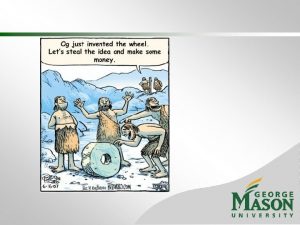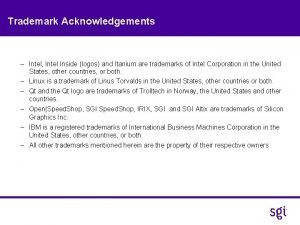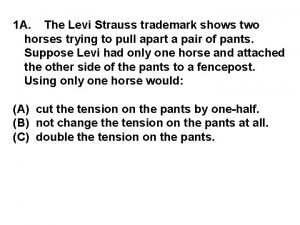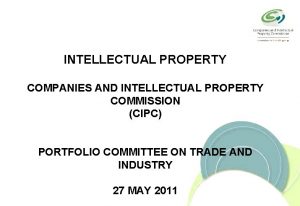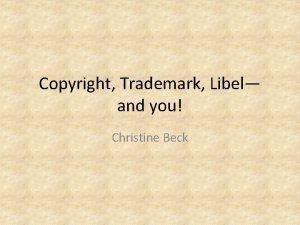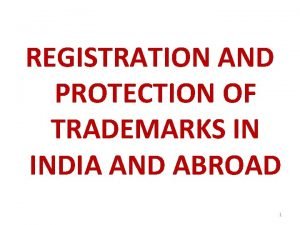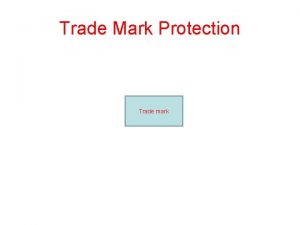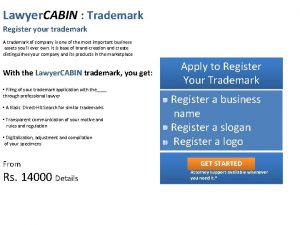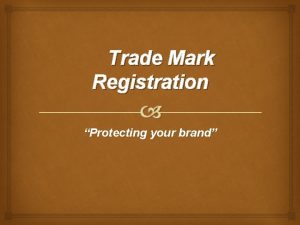Types of Trade Mark WHAT IS TRADEMARK Trademark









- Slides: 9

Types of Trade Mark

WHAT IS TRADEMARK? • Trademark is defined under section 2(zb) of The Indian Trademarks Act 1999 as "mark capable of being represented graphically and which is capable of distinguishing the goods or services of one person from those of others and may include a shape of goods, their packaging and combination of colours. " • In simple words, a trademark may include a device brand heading label ticket name signature word letter numeral a shape of goods packaging OR combination of colours OR any such combinations - Section 2(m). • The only qualification for a trademark being its capacity to distinguish the goods OR services of one person from that of another.

TYPES OF TRADEMARKS • WORD MARKS: Word marks may be letters or numerals. A word mark gives the proprietor a right only in the word, letter or numerical. No right is sought with respect to the representation of the mark. • DEVICE MARKS: Where the trademark lies in the unique representation of a word, letter or numerical; it is called as a device mark.

• SERVICE MARKS: A service mark is nothing but a mark that distinguishes the services of one person from that of another. Service marks do not represent goods, but the services offered by one individual / company. • They are used in a service business where actual goods under the mark are not traded. • It is a mechanism available to protect marks used in service industry. Thus, a business providing services like computer hardware & software assembly and maintenance, restaurant & hotel services, courier & transport, beauty & health care, advertising & publishing, educational and the like are now in a position to protect their names & marks from being misused by others. • As service marks, the substantive & procedural rules governing the service marks are fundamentally the same.

• • • COLLECTIVE MARKS: Marks being used by a group of companies can now be protected by the group collectively. Collective marks are used to inform public about a particular feature of the product for which the collective mark is used. The owner of such marks may be an association / public institution / cooperative. Collective marks are also used to promote particular products which have certain characteristics specific to the producer in a given region. CERTIFICATION MARKS: Certification marks are used to define standards. They assure the consumers that the product meets certain prescribed standards. The presence of certification mark on the product indicates that the product has successfully gone through a standard test specified. It assures the buyer / consumer that the manufacturers have gone through an audit process to ensure the quality of the product. For example: Toys, electrical goods etc; having such marking indicates the safety & the quality of the product. COLLECTIVE MARK vs CERTIFICATION MARK: Collective Mark is used by a particular enterprise / members of the association. Certification Mark may be used by anybody who meets the defined standards.

• WELL - KNOWN MARKS: When a Mark is easily recognised among a large percentage of population it achieves the status of a well-known mark. Well-known marks enjoy greater protection. • Persons will not be able to register or use marks, which are imitations of well-known trademarks. • In order to be well-known, a trademark needs to be known / recognised by a relevant section of people. • These people includes actual / potential customers, people involved in the distribution & business service dealing with the goods / services.

UNCONVENTIONAL TRADEMARKS • Unconventional trademarks are those trademarks which get recognition for their inherently distinctive feature. Unconventional trademarks include the following categories: – • COLOUR TRADEMARK: if a particular colour has become a distinctive feature indicating the goods of a particular trade it can be registered as a trademark. E. G: Red Wine • SOUNDS MARKS: sign which are perceived by hearing and which is distinguishable by their distinctive & exclusive sound can be registered as sound marks. E. G: Musical Notes • SHAPE MARKS: When the shape of goods, packaging have some distinctive feature it can be registered. E. G: Ornamental Lamps. • SMELL MARKS: when the smell is distinctive & cannot be mistaken for an associated product it can be registered as smell mark. E. G: Perfumes.

• On the whole , A trade mark is an important means to protect the good will and reputation of business. While filing a trade mark the applicant may choose any a forementioned types of trade marks based on the nature of mark

Thank You
